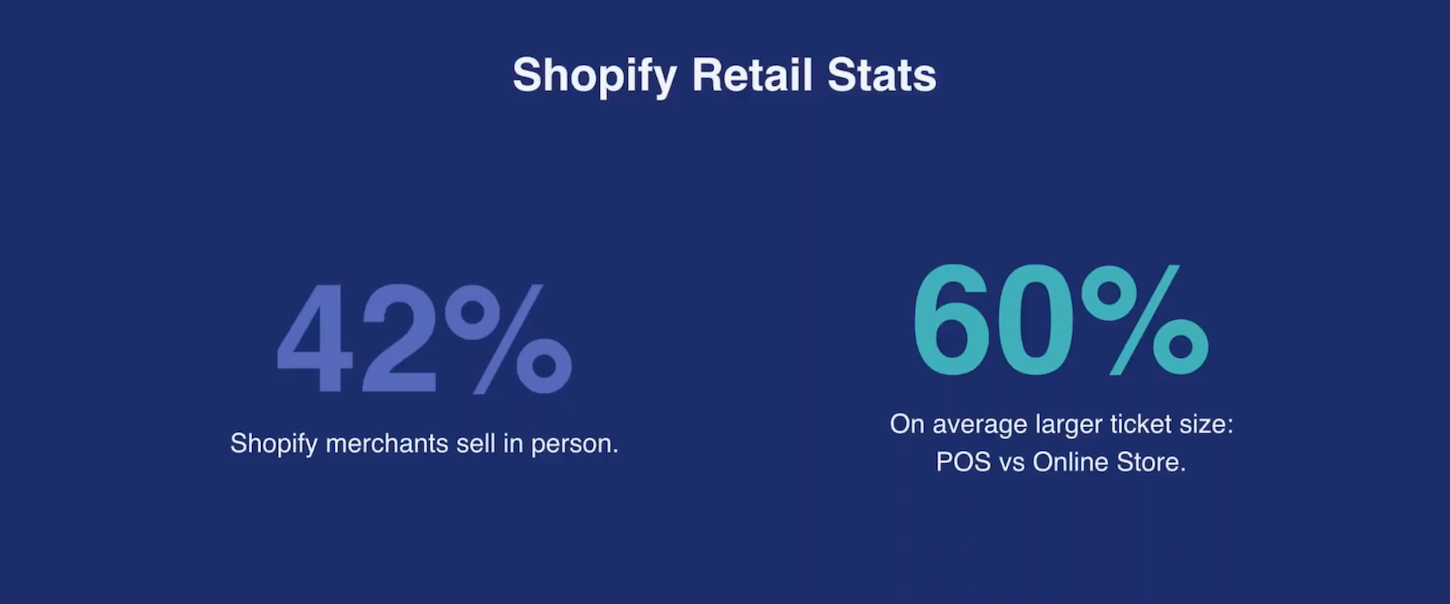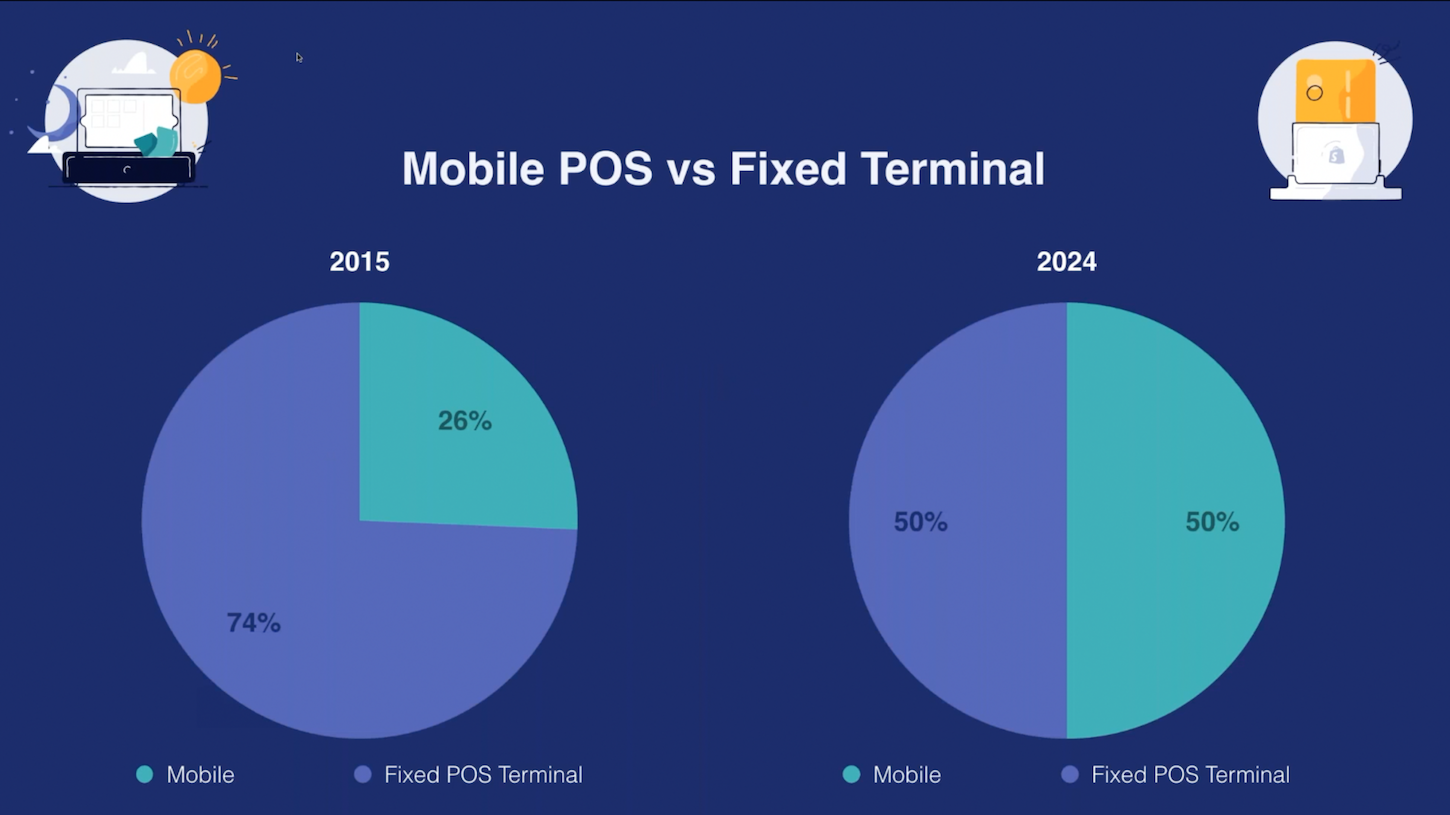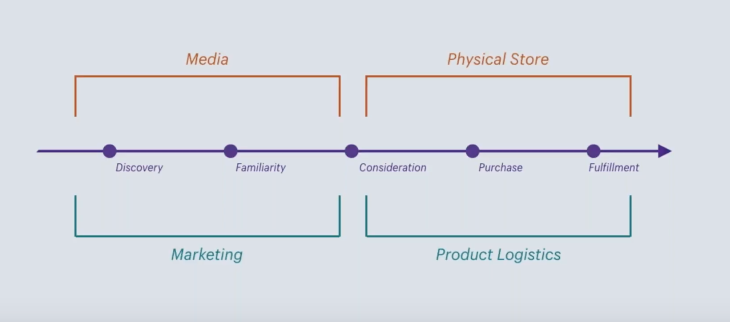There has never been a better time for your clients to get started with Shopify POS , or to add an offline-selling component to their online business.
, or to add an offline-selling component to their online business.
And we want to help you get them excited about everything the new retail era has to offer.
This article will help you speak persuasively to the shift in retail, and how your customers can truly embrace this opportunity to expand their business offline.
To do this, here are five powerful trends you can refer to when pitching Shopify POS to current, or potential, clients .
.
1. Customers are buying more in-person

Did you know that an in-person sale is more valuable to merchants than an online store sale?
Statistically speaking, ticket sizes are 60 percent larger for Shopify POS purchases than online purchases, and other business margins follow this number, as well. 💰
It all comes down to human psychology.
When surveyed about where they prefer to buy, 75 - 85 percent of respondents said they prefer to buy in store. And this makes sense: as humans, we like to communicate, experience the thrill of the hunt, experiment with what’s in front of us, and compare real products with all of our senses.
We like to communicate, experience the thrill of the hunt, experiment with what’s in front of us, and compare real products with all of our senses.
And buying in-person checks all these boxes.
Think about being in your favorite store. While browsing, it’s easy to see your cart (or arms) fill up with items you want. You can look, touch, feel, and compare products. You can decide right then and there if the product meets all of your expectations or not. And once something’s in your cart, you’re less likely to take it out before you end up at the register.
That’s the power of in-person selling.
And your clients no longer need a storefront to leverage the in-person selling experience . All they need is their mobile device, Shopify POS, and a card reader, and they’re ready to sell anytime, anywhere.
. All they need is their mobile device, Shopify POS, and a card reader, and they’re ready to sell anytime, anywhere.
You might also like: Why You Should Add Shopify POS to Your Service Offering.
2. Retailers are moving to mobile tools to enhance offline purchasing

While the opportunity for Shopify POS is much more than the potential to increase average ticket prices, it’s also continuing to narrow the divide between offline and online sales.
In 2015, mobile point of sale solutions like Shopify only accounted for 26 percent of total POS terminals in the United States. By 2024, it’s estimated this number will rise to approximately 50 percent.
Why?
Because retailers are looking to mobilize the interactive, line-busting, shopping experience and provide customers with seamless transactions — like those done online. This ultimately enhances the offline purchasing experience, and allows retailers and merchants alike to create more targeted, situational campaigns to encourage more sales.
Also, less lines = happier customers. 😁
By using Shopify POS, your clients get all the benefits of a point-of-sale solution, as well as the digital integration of Shopify’s online store.
Clients can leverage online customer data for custom in-store interactions, offer a mobile solution for in-person selling, and much more — helping retailers use mobile tools to enhance their offline selling experience.
3. Customers are demanding great experiences and quick fulfillment

Traditionally, ecommerce is low in customer experience, but high in ease of fulfillment.
Customers are browsing for products in their houses, on their phones, or at work; they don’t get to touch, or feel the products they’re trying to buy; and they have to trust that the product will actually meet their expectations once it arrives.
Because let’s be honest, having to mail back an item purchased online is terribly inconvenient.
This is completely acceptable, though, because ecommerce makes it easy to find products and get them delivered to wherever the customer is. The ease of fulfillment is incredibly high, especially with the distribution tactics available to retailers today. Think Amazon one-day shipping, or even drone deliveries.
On the flip side, brick-and-mortar stores offer a rich customer experience, yet actually fulfilling the order is quite difficult.
When in-person, or browsing through a physical storefront, customers get to touch and feel products, see beautiful merchandizing, listen to mood-enhancing music, etc. They get to experience all aspects of the product to help them make more informed buying decisions, eventually increasing the overall satisfaction related to purchasing a product.
But customers have to get to the store, or go to the mall, buy the product, and bring it back home — making the ease of fulfillment extremely low.
I mean, have you ever tried bringing a new Ikea couch home with you? 🙈
Being part of a larger multi-channel product, Shopify POS combines the best parts of online and in-person selling , and allows merchants to accommodate both great experiences and quick fulfillment for their customers, across all sales channels. 🔥
, and allows merchants to accommodate both great experiences and quick fulfillment for their customers, across all sales channels. 🔥
You might also like: How to Get Your Clients Up and Running With Shopify POS.
4. The retail landscape is evolving

Retail is dead.
You’ve probably heard this before, but it’s not really true. Retail is evolving.
Retail is evolving.
And though many cornerstone businesses like K-Mart, American Eagle, and Macy’s are divesting from the retail space — many large companies are investing in it now more than ever. Just in a new way.
Take Nike, for example.
They’ve transformed their flagship store in New York City from a traditional retail space to a 360-degree experience — customers can book custom fittings, athletic consultations, participate in local run clubs, and more.
Target is opening more stores across the United States. Instead of creating large, suburban big-box stores, Target is looking to bring smaller retail spaces to more urban areas. They’ve already seen an increase in revenue from this shift in their retail strategy.
Lululemon uses their retail space to invite customers in for community events, like yoga.
Unlike in the past, where the retail opportunity existed to distribute product, it’s now a means for creating experiences. Retail is no longer about sales per square foot, but experiences per square foot. Gone are the days of the media buy — retailers are now buying experience.
Gone are the days of the media buy — retailers are now buying experience.
Unlike in the past, where the retail opportunity existed to distribute product, it’s now a means for creating experiences.
Stores no longer distribute product — they distribute experiences. And Shopify POS has all the features your clients need to focus on adapting to this evolution in retail.
5. Media is taking over the role of traditional stores, and vice versa

Traditional retail, at its core, is a logistics system designed around the distribution of products for a homogeneous consumer.
Think back to the big stores founded in the 1960s: Best Buy, Gap, Crate and Barrel, Walmart.
These stores were immediately successful because, at the time, America was a largely uniform demographic with similar consumer preferences. This meant retailers could design products at a baseline that worked at scale — creating a predictable strategy for distributing these products.
This uniformity also made it easy to create floor plans for physical stores.
But today, the middle class is shrinking, the socio-economic landscape is changing, and we’re more culturally diverse now than we’ve ever been.
Traditional retail isn’t working anymore. Enter ecommerce:
- Consumers can now purchase products anytime, anywhere.
- Product scarcity is nearly eliminated.
- More diverse products are being purchased from different markets.
- Online distribution of product makes it easier for businesses to scale.
And underpinning digital commerce is a completely new distribution model: Digital media. Historically, media was used for marketing; to increase the discoverability and familiarity of products to consumers. Now it facilitates the consideration, purchase, and fulfillment phase of the purchasing lifecycle.
Think of the many sales channels Shopify offers: consumers can purchase from Facebook, Instagram, Buzzfeed, Pinterest, and more.
Media has effectively replaced the traditional store.
So now, the true value of physical stores has become experience — and they’re the most valuable touchpoint for brands.
Shopify POS helps blend ecommerce with traditional brick-and-mortar to bring a multi-channel approach to commerce — allowing merchants to leverage various sales channels, and media, to embrace the future of retail and what constitutes the new store.
You might also like: Learn to Build Apps for In-Person Sales Using Shopify's POS App SDK.
This is just the beginning 🚀
Now that you can speak persuasively to current trends in retail, the power of Shopify POS, and show your clients the opportunities adding an offline component to their business has to offer — you’re ready to start pitching.
We look forward to seeing all of the amazing things you’ll do! 😁
Want to learn more about POS? Let us know what you’d like us to cover in the comments section below.









